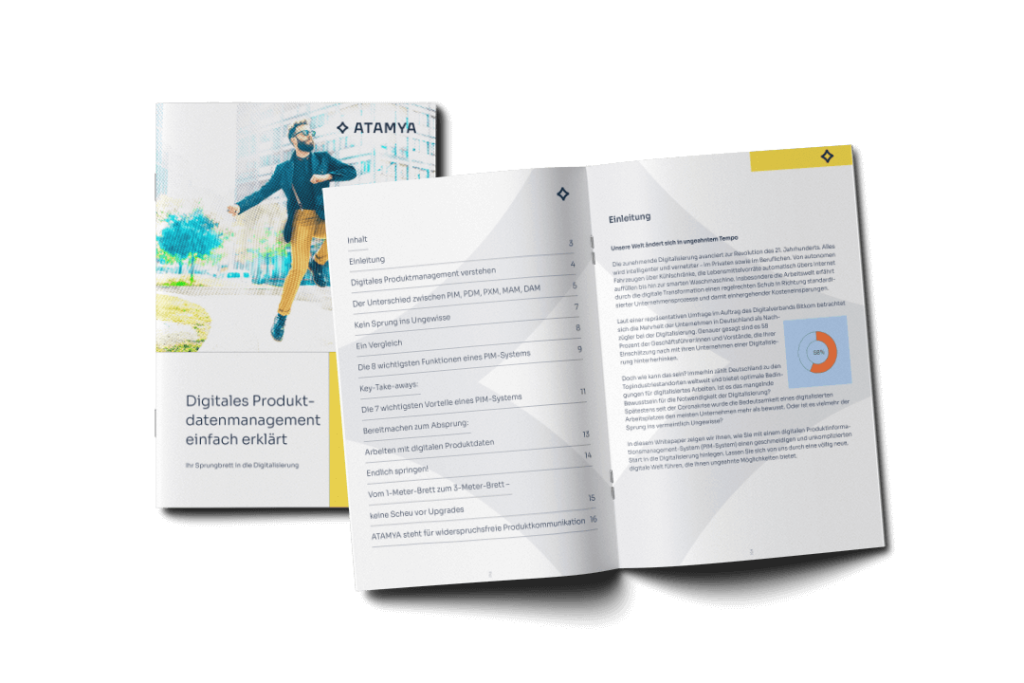Where product data (and its onboarding) really begins
Sooner or later, PIM users encounter a frequently underestimated topic: data onboarding. This term refers to importing external data into one’s own systems – for example, into an ATAMYA instance. Depending on the context, it’s also called “supplier data onboarding”.
Merchants and wholesalers typically receive product data from various sources such as manufacturers, suppliers, or data pools. Each data supplier manages their data differently — some use Excel spreadsheets, others use a PIM. In addition, there are many data exchange formats like CSV, XLSX, XML, JSON, and data standards such as BMEcat or ETIM xChange.
What works for the individual supplier often poses challenges for the data recipient. So, how can different datasets be consistently and accurately imported into ATAMYA serving as the central platform for managing structured product information? The answer lies in a clearly structured, efficient data onboarding process supported by middleware acting as a “translator” between data supplier and recipient.
This article explores why data onboarding is more just than a technical necessity, and how to optimize it within your product data management.
The role of data onboarding in the product data chain
Admittedly, data onboarding isn’t exactly a hot topic for small talk. But why is this part of product data management often treated as secondary? Data onboarding is often dismissed as a minor preliminary step before PIM maintenance. However, considering the entire product data journey — from creation to presentation and marketing — data onboarding actually plays a crucial role throughout the content supply chain, from manufacturer to end user.
However, when you consider the entire journey that product data takes from its initial creation to the final product presentation and marketing, this assessment is put into perspective. It quickly becomes clear that data onboarding actually plays a key role along the entire “content supply chain”. This refers to the complete flow of data from the manufacturer to the retailer and finally to the customer or end user.
One reason is the quality assurance function of data onboarding: it ensures that low-quality external data can’t even be imported into internal systems and cause further issues. The reality is: product data management processes in a PIM are only as effective as the quality of the data they rely on.
The takeaway: Those who import high-quality, standardized, and clean data into their PIM system lay the foundation for automated workflows, omnichannel syndication, and sustainable data quality – within the PIM and beyond. Product visibility in search engines, online shops, and marketplaces depends heavily on the freshness, completeness, clarity, and overall presentation quality of products. Essentially, high quality product data helps reduce return rates and increase sales potential.
The PIM as the central hub for internal and external product data
The need for high-quality product data in the context of data onboarding is closely tied to the very nature of PIM systems. Systems like ATAYMA serve as what is known as a “Single Point of Truth” (SPOT) – a central and consistent source of product information. A cross-departmental use of the PIM also helps prevent the formation of data silos – isolated, disconnected datasets that may contain inconsistent information about the same products. In short: where data silos exist, confusion follows. And PIM systems are designed to prevent exactly that.
Everyone accesses the same centralized data pool, ensuring a uniform and reliable data foundation across the company. Product manufacturers can create data for new items directly in their own manufacturer PIM system. Wholesalers then receive this data and import it into their own PIM environment. Once stored in the system, the data can be continuously updated, enriched, and published. Sales and marketing teams, for example, use PIM data to create compelling product descriptions and promotional campaigns. However, this requires active data management: all product data must be kept up to date, complete, and informative at all times.
How does external product data get seamlessly imported into your ATAMYA system?
The key question is: How can different external product data be consistently and efficiently imported into ATAMYA? To achieve this, companies often rely on intermediary software solutions – so-called “middleware”.
These specialized supplier management tools (e.g. in the form of a supplier portal) enable distributors to define clear specifications for how they accept product data deliveries. Each supplier can align their data with the required data structure (e.g. the field structure in ATAMYA). This can be achieved using a data mapping process that matches the supplier’s source fields to the defined target format.
Versatile data onboarding software also allows distributors to configure how supplier roles are managed – whether suppliers are permitted to manage their data themselves, whether the distributor takes over this task on behalf of the supplier, or whether a hybrid role is preferred.
Before supplier data is transferred into the ATAMYA system via interface integration, middleware users can set up and manage various data management processes, including the
- Integration with source systems via interfaces (e.g. to the manufacturer’s PIM, ERP, MDM, DAM, or individual CSV file sources),
- Data merging across multiple sources into a unified dataset,
- Data transformation to adapt source data to the target data structure required by ATAMYA, and a
- Final data validation to check whether the external data meets the structural requirements or requires further adjustments before it can get imported.
A product data classification in the PIM — whether custom or standards like ETIM or ECLASS — can also be generated and automatically exported this way.
What are typical data onboarding challenges for companies?
Those who regularly work with (external) product data are likely familiar with common obstacles: Excel files with freely named columns, incomplete mandatory fields, format inconsistencies, or media links leading nowhere. In some cases, data is not updated frequently enough – or the updates are not passed on to data recipients in a timely manner.
These practical examples highlight a typical situation: in addition to clearly defined rules for data enrichment, many companies simply lack the technical infrastructure needed for smooth product data management. Especially when handling large volumes of product data, interface integrations – for example via REST API – with middleware solutions, as well as external and internal systems, are indispensable.
In many data onboarding workflows, another issue becomes apparent: the lack of a clearly defined set of requirements. To address this, PIM users (being the data recipients) can reflect on questions such as:
- How should the overall data onboarding process be organized? Should suppliers manage their data independently within the onboarding middleware?
- What data structures exist in my PIM system – and have I clearly communicated these requirements to my data suppliers?
- Which data fields must or can be completed by my suppliers? Which fields are optional?
Experience shows that data management processes tend to function reliably when they are both technically well-designed and clearly communicated.
Data onboarding automation: also a matter of communication
Once these data structures are clearly defined, the foundation is in place for an automated data onboarding process. However, such a process relies not only on the right middleware but also on clear communication. Only if both sides understand what matters in terms of data delivery, data transformation, and data distribution can potential issues be avoided from the outset.
However, an automated data onboarding process depends not only on the right middleware, but also on clear communication. Only when both sides – the data supplier and the data recipient – know what is important when it comes to data delivery, data transformation, and data export can potential problems be avoided in advance.
An efficient data onboarding workflow typically begins with the appointment of clearly defined contact persons who are responsible for managing and supervising the process. The technical implementation is then based on the definition of user roles and access rights, the connection of data sources (such as a PIM, ERP, or individual files), the integration into the ATAMYA PIM as the target system, the creation of data mapping structures, and the setup of customizable or standardized data validation rules.
Experience from numerous data onboarding projects shows: yes, setting up such a workflow involves an initial effort. But this effort pays off quickly – through higher data quality, fewer follow-up questions, and a shorter time-to-market.
Top 5 Learnings for Successful Data Onboarding
This article makes one thing clear: professional data onboarding is not magic – it’s the result of a well-aligned interplay between technology, processes, and people. In practice, the following five aspects have proven particularly valuable:
- A shared understanding of data quality – because without clean, complete, and consistent product data, no data onboarding process can run efficiently.
- Clear roles, expectations, and responsibilities – suppliers need to know exactly what is required, in which format, and under what conditions.
- Technical support through validating middleware solutions – to automatically check, transform, and forward data in a structured way.
- Open and ongoing communication – data onboarding isn’t a one-off task but thrives on continuous exchange between all stakeholders.
- Seamless integration with the PIM system – for example, via a supplier portal that consolidates every step up to the structured import into the ATAMYA PIM.
When all these elements come together, data onboarding becomes what it truly is: a foundational building block for commercial success in today’s digital business landscape.






